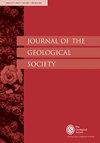从冷的低硅岩石到热的高硅熔体的晶体夹带:新西兰塔拉纳基火山不同的初级熔体成分
IF 3
3区 地球科学
Q2 GEOSCIENCES, MULTIDISCIPLINARY
引用次数: 1
摘要
在弧火山岩中普遍存在的反晶被广泛接受,但其载体熔体的起源仍存在争议。新西兰塔拉纳基火山熔岩流中的结晶以斜长石、斜辉石和角闪石为主。除了一些晶体外,矿物相与它们所夹带的熔体是不平衡的。主要元素化学表明,熔岩中的晶体和捕虏体中的晶体在成分上几乎完全重叠。晶体的大体积分数(35-55 vol%)对整个岩石成分有很强的控制作用,与载体熔体相比,二氧化硅减少了5-11 wt%。然而,矿物比例与岩石整体组成之间没有明确的关系。我们的数据与广泛的分馏结晶不一致,分馏结晶通常被认为是岩浆向富硅成分演化的驱动因素。相反,具有不同成分(55-68 sio2 wt%)的高温、干燥载体熔体在穿过较冷的低硅岩石时携带晶体货物。因此,塔拉纳基火山的一些原生熔体明显比通常被称为母岩浆的弧玄武岩富含硅。此外,温度和湿度限制排除了这些熔体来源的深部地壳热区,我们认为这些熔体是地壳下起源的。补充资料:https://doi.org/10.6084/m9.figshare.c.6406813本文章由计算机程序翻译,如有差异,请以英文原文为准。
Crystal entrainment from cool, low-silica rocks into hot, high-silica melts: diverse primary melt compositions at Taranaki volcano, New Zealand
The prevalence of antecrysts in arc volcanic rocks is widely accepted, yet the origin of their carrier melts remains debated. Crystal cargo in lava flows from Taranaki volcano, New Zealand, is dominated by plagioclase, clinopyroxene, and amphibole. Except for some crystal rims, mineral phases are in disequilibrium with the melt they are entrained in. Major element chemistry reveals an almost complete compositional overlap between the crystals in the lava and those in xenoliths. The large volume fraction of crystals (35–55 vol%) exerts a strong control on whole-rock compositions, reducing silica by 5–11 wt% compared to the carrier melt. Yet there is no clear relationship between mineral proportion and bulk rock compositions. Our data are inconsistent with extensive fractional crystallization, commonly invoked as a driver of magma evolution towards silica-rich compositions. Instead, high-temperature, aphyric carrier melts with varied compositions (55–68 SiO
2
wt%) entrain crystal cargo while ascending through colder, low-silica rocks. Thus, some primary melts at Taranaki volcano are significantly more silica-rich than arc basalts commonly invoked as parental magmas. Further, thermometric and hygrometric constraints preclude a deep crustal hot zone for the source of these melts, which we argue are of subcrustal origin.
Supplementary material:
https://doi.org/10.6084/m9.figshare.c.6406813
求助全文
通过发布文献求助,成功后即可免费获取论文全文。
去求助
来源期刊

Journal of the Geological Society
地学-地球科学综合
CiteScore
6.00
自引率
3.70%
发文量
68
审稿时长
6-12 weeks
期刊介绍:
Journal of the Geological Society (JGS) is owned and published by the Geological Society of London.
JGS publishes topical, high-quality recent research across the full range of Earth Sciences. Papers are interdisciplinary in nature and emphasize the development of an understanding of fundamental geological processes. Broad interest articles that refer to regional studies, but which extend beyond their geographical context are also welcomed.
Each year JGS presents the ‘JGS Early Career Award'' for papers published in the journal, which rewards the writing of well-written, exciting papers from early career geologists.
The journal publishes research and invited review articles, discussion papers and thematic sets.
 求助内容:
求助内容: 应助结果提醒方式:
应助结果提醒方式:


